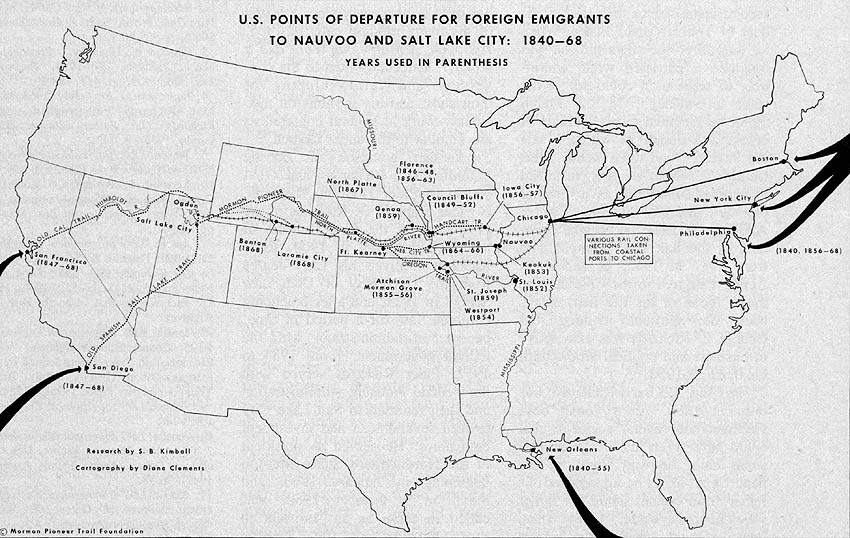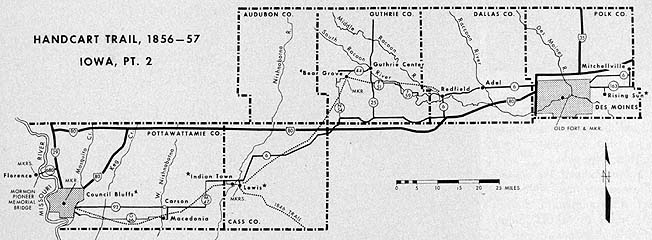“Eastern Ends of the Trail West,” Ensign, Jan. 1980, 30
Eastern Ends of the Trail West
General Emigrant Routes, 1840–68
From 20 July 1840, when the first Mormon converts arrived in New York City from England, to 1 May 1869, when the first transcontinental railroad was completed, Mormons officially developed or used twenty-two points of departure, or staging grounds, from New York to California. From each of these points, all Saints except those who came via California eventually picked up the famous Mormon Trail and followed it to Zion.
Only the first two groups of English immigrants in 1840 debarked at New York City; for the fifteen years thereafter all European immigrant groups sailed to New Orleans and then up the Mississippi River to various points of departure. After 1856, immigrants could go by railroad to Chicago and beyond, so they again landed in New York City, and also in Boston and Philadelphia. Until 1845 they went straight to Nauvoo, Illinois. Afterwards these other points of departure were developed:
-
Winter Quarters (later Florence), Nebraska, 1846–48
-
Council Bluffs, Iowa, 1849–52
-
Saint Louis, Missouri, 1852
-
Keokuk, Iowa, 1853
-
Westport, Missouri, 1854
-
Mormon Grove, Kansas, 1855–56
-
Iowa City, Iowa, 1856–57 (There was no formal immigration in 1858 because of the “Utah War.”)
-
Florence, Nebraska, 1856–63
-
Saint Joseph, Missouri, 1859
-
Genoa, Nebraska, 1859
-
Wyoming, Nebraska, 1864–66
-
North Platte, Nebraska, 1867
-
Laramie City, Wyoming, 1868
-
Benton, Wyoming, 1868
A relatively small number of Saints from New York, Europe, and the Pacific area entered the United States at San Diego and San Francisco and followed either the Old Spanish Trail or the Old California Trail to Utah.
The Union Pacific Railroad began moving west from Omaha, Nebraska, 10 July 1865. Thereafter, Mormons took trains to three different Union Pacific railheads: North Platte, Nebraska, in 1867, and Laramie City and Benton, Wyoming, in 1868. The first two settlements prospered, but Benton has the distinction of becoming the first ghost town in Wyoming. (The town lasted only three months—from July through September 1868.) On the eastern edge of the Red Desert, eleven miles east of Rawlins, near the North Platte River, the site of vanished Benton is marked today by a Union Pacific milepost exactly 672.1 miles west of Omaha.

U.S. Points of Departure for Foreign Emigrants to Nauvoo and Salt Lake City: 1840–68
The Mormon Grove Saints’ Trail, 1855–56
Between 1848 and the completion of the transcontinental railroad in 1869, the Mormons developed several points of departure for the Far West. Most of these outfitting stations were located along the Missouri River. During 1855–56 the preferred place was Mormon Grove, Kansas, four miles west of Atchison, an important Missouri River port city. Located on the prairie at the head of Deer Creek, Mormon Grove was an excellent camping place with water, wood, and range for stock. And, like the other Mormon camps along the Missouri, it was close enough to the port city so the Saints could easily purchase supplies, but it was far enough away to allow space for tent cities and grazing animals, and to avoid the assorted evils of river ports.
Soon after the first Mormons arrived there in April 1855, they fenced 160 acres, a quarter section, and planted twenty. That year eight companies, totaling 2,041 people and 337 wagons, left Mormon Grove for Zion. A group of fifteen members remained behind to await the next year’s immigrants. During the 1856 season, however, only one company of ninety-seven Saints left from Mormon Grove. Most immigrants were then going directly by rail from the east coast to Florence, Nebraska.
At Atchison the Saints debarked the river boats at the foot of Atchison Street. From there today’s traveler should take Highway 73 approximately 4.5 miles straight west and turn south on a section road. The first farmhouse on the west side of the road marks the farm of Mr. Floyd Armstrong, where the old cemetery—all that is left of Mormon Grove today—is located. At least sixteen Mormons were buried there, but no traces of the graves remain.
Back on Highway 73, going west to Horton, you will pass through Lancaster, a stage stop on the old road. Two miles from Horton is Kenekutt stage stop. (Ask locally for directions.) Stage stops in the area that no longer exist are Capinoma, just north of Granada, and Richmond, three miles north of Seneca.
The great Oregon Trail was not just a single trail; it had at least two main branches and many feeder trails. The Mormon Grove Trail, part of the Fort Leavenworth Military Road, was one of the many feeder trails. Near Maryville, the trail crossed the Big Blue River and joined the Oregon Trail proper, which then followed the Little Blue as far as possible towards Fort Kearney, Nebraska. (Later, the Pony Express Trail from Saint Joseph followed much the same route. Pony Express fan should visit the stations in Seneca and Hollenberg.)
The Mormons spent little time at Fort Kearney. Instead, they forded the Platte there, picked up the old 1847 Mormon Trail north of the river, and followed it to the Valley.
Between Steel City, Nebraska, and Fort Kearney, the state of Nebraska has erected thirty-four markers. These can help travelers gauge how close they are to the old Oregon/Mormon Grove Trail. East of Fort Kearney, this trail was joined by another feeder trail, the Nebraska City Cutoff Trail, which Mormons used in the 1860s.

Mormon Grove Trail, 1855–56 Nebraska

Mormon Grove Trail, 1855–56 Kansas
Handcart Trail, 1856–57
In 1856, when rail travel was finally possible from the east coast clear to Iowa, Iowa City became the point of departure for the Valley. Thousands of European converts, mainly from England, Wales, and Scandinavia, landed in New York, Boston, and Philadelphia and traveled by train via Chicago for Iowa City, the end of the Mississippi and Missouri Railroad.
The train was faster and more comfortable than the ox cart, but hardly luxurious. Averaging twenty miles an hour, without sleeping or eating accommodations, the smokey, sooty trains operated on wildly erratic schedules. But on the Saints came.
Immigrants debarked at Iowa City from a depot only three blocks east of the present one, crossed the Iowa River, and went to the staging area three miles away—a small settlement known as Clark’s Mills (later called Coralville) situated on the banks of Clear Creek.
From there, the journey of many Saints after 1856 took on an unusual dimension. Handcarts, claimed to be faster, cheaper, and easier, were their mode of travel. The famous handcart experiment involved 2,962 people in nine companies from 1856 through 1860, but only the first seven companies (2,071 Saints; 67 percent of the total) trod Iowa soil. The last two companies were able to ride various railroads all the way to Council Bluffs/Florence.
With the exception of companies four and five—the famous Martin and Willie companies, which started too late in the year and were trapped in Wyoming snows—the system was a success. But after 1860 the Church sent large ox-team trains to haul immigrants to the Valley from the Missouri River and other points west.
In Coralville, the Daughters of the American Revolution have erected a bronze tablet commemorating the handcart companies just west of the intersection of Fifth Street and Tenth Avenue, on the south side of the road. Immediately south of this intersection, flowing parallel with Highway 6, is Clear Creek. Also in Coralville is the Mormon Trek Boulevard.
Like all Mormon pioneers before and after them, the handcart pioneers used the best, most convenient roads and trails. Since at least 1846, when Brigham Young led the Saints across Iowa, there had been a road of some kind between Iowa City and Council Bluffs. Beginning as a military road, it served later as a territorial, state, mail, and coach route. Most of the handcart journals of 1856–57 refer often to the good Iowa roads. In fact, had the Saints not been so poor, they could have ridden by coach to the Missouri River for about $11.00.
Today’s Highway 6 follows this old trans-Iowa road, one of the oldest and most historic in the state. From Coralville, the pioneers passed through Homestead and South Amana, two German colonies established in 1854. (This part of Highway 6 up to Grinnell is also officially marked as the Hiawatha Pioneer Trail.) Passing slowly through Marengo (the future site of Brooklyn), Grinnell (the future site of Kellogg), Newton, and Rising Sun, they reached Fort Des Moines. The old fort on the west bank of the Des Moines River was abandoned at the time, but still standing. Near the intersection of Riverside Drive and South West First Street is a granite marker and part of the newly restored fort.
West of Des Moines, the Mormons proceeded via Adel and Redfield to Bear Grove. Merely a wide spot in the road today, Bear Grove was then an important coach stop, a place where the pioneers obtained needed supplies. (Ask locally for directions to Bear Grove.)
From there the Saints traveled the old Dragoon Military Road, now largely non-existent but approximating the dotted line, to Council Bluffs. At Lewis they intersected the older 1846 Pioneer Trail and followed it directly to Council Bluffs, where, crossing the Missouri by ferry, they arrived at the new staging ground in Florence, Nebraska, and made final preparations to follow the famous Pioneer Trail to the Valley.
The 275 mile trip from Iowa City to Council Bluffs/Florence took handcart companies from twenty-one to thirty-nine days—an average of twenty-five days, eleven miles per day. But although these handcart pioneers did not know it when they arrived, Iowa roads were veritable superhighways compared to those west of the Missouri.
Two markers in the Lewis town square commemorate the Mormon Trail. One, a section of a telephone pole, has “Mormon Trail” carved into it; the other is a handsome bronze marker placed by the Daughters of the American Revolution in 1917. In the camping area of Cold Spring Park, two miles south of Lewis, is a third, telephone pole-type marker.

Handcart Trail, 1856–57 Iowa, Pt. 1

Handcart Trail, 1856–57 Iowa, Pt. 2